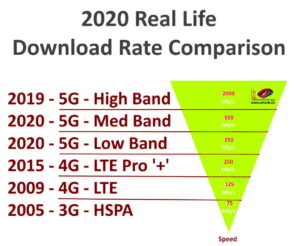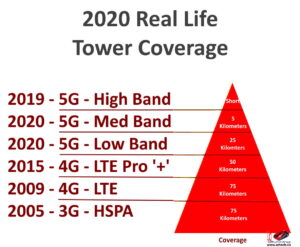A few days ago Apple released its delayed 5G lineup of cell phones and while many other companies have had 5G devices for more than a year, the Apple announcement did create a buzz. This is because now there is a full spectrum of choices as all major device manufacturers, including Samsung, LG, Motorola, Huawei, Xiaomi and even Apple have 5G devices available. The questions you are likely asking yourself now are:
- Why does 5G actually do?
- Does the choice of 5G carrier (Verizon, AT&T, Telus, Bell, TMobile, Orange, BT…) really make a difference?
Most people understand that 5G is “better” but don’t really know why. Many have heard of problems with 5G signals being dropped because they won’t travel through walls or heavy rain/snow. Still others may be aware that 5G network are still being rolled out so their 5G cell phone might operate at 4G because that is all that is available in their region.
We edited an excellent Bloomberg interview with T-Mobiles Mike Sievert where he explains that benefits of the various 5G networks and augmented it with definitions and graphics so you can easily understand the differences:
To make things clearer, we developed a simple info graphic that explains 5G network options and how they compare to 3G and 4G. In simple terms, 5G is broken into three “bands” (aka spectrums) and each band has it’s own characteristics. The full 5G graphic with all of the metrics is HERE but two of the more important characteristics, download speed and tower coverage are below.
Click to Enlarge Graphics
As you can see, High, Mid and Low Band 5G networks are like the years 2010, 2015 and 2020; all very different with their own peculiar performance benefits. For instance Low Band 5G may provide download speeds comparable to the latest 4G implementations (like AT&T’s so called “5G Evolution” which is really just the next iteration of 4G technology) but it will cover a vast areas in the rural countryside. Contrast that with 5G High Band (aka Millimeter Wave 5G) which will operate today at 10 to 15 times the speed of most current 4G LTE networks but will only work when you are very close to a cell tower.
If you still have questions this short podcast from the amazing Daily Tech News Show should help:
… and if you still have questions, just drop us a comment below and we will get back to you.





2 Comments
SOLVED: What Is 5G UC and 5G UW? – Up & Running Technologies, Tech How To's · August 4, 2023 at 1:54 pm
[…] In 2020 we developed these graphics to visually explain the differences between 5G standards: […]
5G Is Here, What Do I Need To Know? – Up & Running Technologies, Tech How To's · February 9, 2023 at 9:31 pm
[…] of the most exciting things about 5G is its ability to support the Internet of Things (IoT), meaning a wide range of devices, such as […]